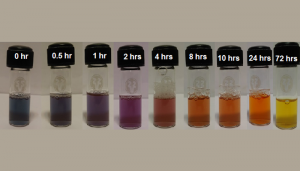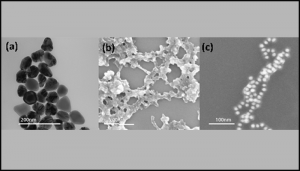Arunangshu Biswas received his doctorate in Computational Natural Sciences. His research work was supervised by Prof. Tapan K Sau and thesis reviewed by Prof. Nikhil Ranjan Jana (IACS Kolkata), Dr. Subir Kumar Roy (DMRL, DRDO Hyderabad) and Prof. Harjinder Singh (CCNSB, IIIT Hyderabad)
Here’s a summary of Arunangshu’s thesis, Studies of the Chemical and Photochemical Tuning of Selected Gold and Polymer Nanoparticle Systems as explained by him:
Metallic and polymeric nanomaterials have been at the forefront of studies and applications for a long time. Development of new, greener, fast, scalable, and controlled synthesis methods, understanding their structures and properties, and exploration of new uses and futuristic applications of these nanomaterials have been the major goals of the researchers recently. The term “nano” comes from the Greek ‘Nanos’ meaning ‘dwarf.’ 1 nm is a millionth of a millimeter or a billionth of a meter. Generally, materials which are between ~1 and 100 nm, at least in one dimension, and show unique dimension-dependent properties, are termed as nanomaterials. We have currently learnt to craft and manipulate these materials at extremely small, nanometer length scales producing ‘nanostructures’ and ‘nanomaterials’ of varying sizes, shapes, and structures for a given composition. This has opened doors to a new world of materials.
My thesis work involves the studies of some nanoparticle systems of the metal, gold and a conducting polymer (CP), polypyrrole. Gold nanoparticles are one of the most extensively studied nanomaterials systems due to their stability, tunable optical properties, and facile surface chemistry and are promising for wide ranging applications in nanomedicine, catalysis, electronics, and so on. Among various kinds of polymers, conducting polymers (CPs) are especially important because they add up the unique structure-dependent conducting property to the other useful properties of a polymeric substance. Since the properties of the nanomaterials depend on their size, dimensional anisotropy, structure, and crystallinity, there is a constant effort to develop ways to tune such nanomaterials features and hence the properties. Though a substantial progress has been made in the size and shape-controlled synthesis of metal nanoparticles, on the contrary, the post-synthesis tuning of the size and morphology of the nanomaterials is a relatively less explored area. However, such post synthesis size- and morphology-tuning of nanomaterials can offer novel materials-features that are difficult to obtain otherwise. New facile, faster, greener, and economic methodologies to manipulate materials at the nanoscale are the need of the day. We discuss various chemical and photochemical methodologies that we have explored and developed for the controlled post-synthesis tuning of the size and morphology of diverse kinds of gold nanoparticles. We have demonstrated a simple, rapid and practical method that allow post-synthesis tuning of the size and surface morphology of different kinds of gold nanoparticles under mild conditions. Excellent surface-enhanced Raman scattering substrates have been prepared by the tuning of the gold nanoparticles.

| Figure 1. Photographs showing progressive color change of the aqueous dispersions of gold nanoparticles and its product at various time period via chemical etching process. |
Our studies involving photochemical post-synthesis modifications of three different kinds of nanoparticles have been presented. UV-C light has been used for the photochemical etching of the gold nanoparticles. We have demonstrated that one can easily and controllably modify the morphologies of the preformed gold nanoparticles by using the photochemical and chemical etching methods by tuning the exposure of UV-light and other reaction parameters. The photochemical method is not only very fast and straight forward but also does not need any

| Figure 2. TEM images of etched gold nanoparticles and SEM images of polypyrrole (PPY) as well as showing coating of PPY on gold nanoparticles. TEM images of (a) Spherical stage of etched gold nanoparticle and SEM images of (b) photochemically synthesized PPY and (c) photochemically PPY coated gold nanoparticles. |
tedious process or sophisticated equipment. The studies of the effects of the post-synthesis treatments of three different kinds of gold nanoparticles on their catalytic and SERS properties, which are known to be highly sensitive to the surface characteristics of the nanomaterials. We have explored an oxidative single step photo-polymerization technique for the synthesis of polypyrroles (PPYs) and using the previous developed photochemical method of PPY synthesis was successfully extended to the synthesis of the core-shell type of Au@PPY nanoparticles. It appears to be a rapid and facile photochemical route for the controlled polypyrrole coating on the surface of the gold nanoparticles. The synthesized Au@PPY nanoparticles show good SERS and catalytic activities.

